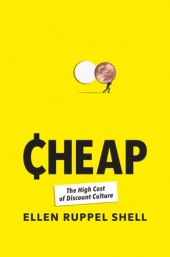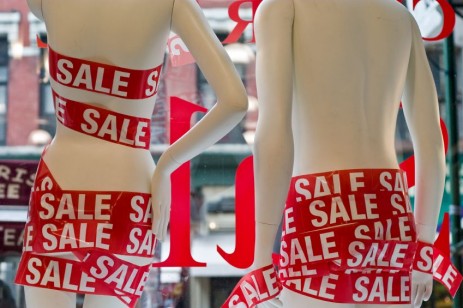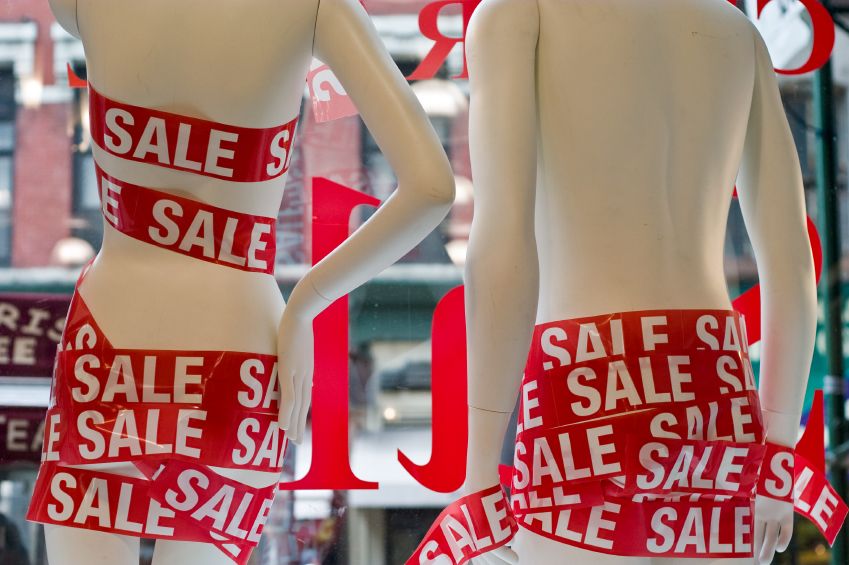 American retail is riddled with cheap, fall-apart merchandise. We know this. Sales are a ploy to get a shopper to spend, as opposed to a boon for penny pinchers. Right. And how much mileage do we get from that old, overused adage, “You get what you pay for”? More than we’d like to admit.
American retail is riddled with cheap, fall-apart merchandise. We know this. Sales are a ploy to get a shopper to spend, as opposed to a boon for penny pinchers. Right. And how much mileage do we get from that old, overused adage, “You get what you pay for”? More than we’d like to admit.
So why is Ellen Ruppel Shell’s new book, Cheap: The High Cost of Discount Culture, so shocking?
Shell deftly weaves a compelling, cautionary tale out of disparate strands: the psychology of manipulating shoppers, the environmental costs of our lust for inexpensive things, the deskilling of the retail industry, and the loss of appreciation for “quality.” Tracing the history of discount culture from the yesteryear excitement over brown paper packages to today’s ambivalence about crammed plastic bags, Shell shows us why we feel we’ve been ripped off if we pay “full price.”
She pushes readers to ponder the strange circumstances that make an item shipped from thousands of miles away less expensive than something homegrown. And how a major furniture retailer can convince a customer to get attached to a piece just enough to buy it, but not enough to keep it long. And, most disturbingly, just how expensive our bargain hunting is turning out to be.
_____
 Ellen Ruppel Shell
Ellen Ruppel Shell
Q. What audience did you have in mind when you wrote Cheap?
A. This grew out of my own curiosity about my own behavior. Since I have a science background, and I try to be a very rational person, I was startled by my own shopping behavior. So if that was happening to me, I figured it was happening to an awful lot of people. As someone who is socially conscious, I was making purchasing decisions that didn’t reflect that social consciousness sometimes. I wondered what was behind that.
I’m trying to reach a thoughtful audience, and I’m particularly interested in reaching younger people because I think they have the spirit and the opportunity to change. Interestingly, it seems to resonate with young people quite a bit.
Q. Why do you think your message is resonating with young people, especially considering how inclined they are to move around and not get attached to their property?
A. I don’t want to speak for all young people, but there are all sorts of ways to get value without playing into this con game of cheap.
You go to a place we have in my town [Boston], called the Garment District, which is second-hand, third-hand kind of clothes, and you can get really good stuff there for very little money. You can be creative with it — dress it up or dress it down, do what you want with it. It’s not a cookie-cutter piece out of H&M that everybody’s wearing that week. You’re the boss of that thing, it’s not the boss of you. It’s style rather than fashion.
The idea that you can go to IKEA and get good deals — it’s really not a good deal. You can’t ever get rid of it, it’s not something you can resell. You don’t really own it; you’re kind of renting it. So that’s something that young people who are thinking about moving can think about. What you want to do is to be able to put it on craigslist, or maybe get your friends to help you move your stuff. You want your stuff to [have] resale value if you really want to save money. You’re not being cheap, you’re being smart. They’re two different things.
Q. How does the psychology of marketing inhibit the ability of consumers to see an item in terms of its entire lifespan?
A. IKEA names all its products to make stuff seem cute, but then they’re telling you, “You’re not really attached to this, are you crazy?” They’re getting you to laugh at and make a mockery out of the idea of durability. They make durability seem like an old-fashioned, passé idea. And it works. I think it’s really juvenilizing: “Oh, come on, you want a new toy. You always want a new toy.”
Particularly in the marketing of cell phones. You have a cell phone that works really well for you, and then you have a friend who has a cooler one, and you want it. That’s kind of 4-year-old behavior. When you have 3- or 4-year-olds, they want the new shiny thing. But as you get older and a little more mature–and I don’t mean 50, I mean 16 or 17–you learn that that’s not what it’s about. It’s about what works for me. Marketers obviously don’t want you to think that. In the case of the cell phone, they assume you’re going to use it for a year or less, and it’s not durable. Even if it is, they assume you’re going to junk it. I say, “Screw them!” If it works for you, hang on to it. Don’t buy into that, because basically, it’s all about them making a profit. It’s not about you and what you really want.
 Come hither — cheap goods for sale!Q. Do you see similarities between the psychology of marketing cheap goods and of greenwashing?
Come hither — cheap goods for sale!Q. Do you see similarities between the psychology of marketing cheap goods and of greenwashing?
A. Yes, I do. There’s a mnemonic device that’s used by marketers in terms of discounting. The mental shortcut is, “Lower price, good deal.” And those two things don’t necessarily follow. Something that’s low price triggers the impulsive side of our brains and causes us to make decisions without much thought. The same thing is true for some of this green marketing. We’re told that something is green, or it has the aura of green, and that makes it OK to buy it.
That’s actually why I [focused on] IKEA instead of Wal-Mart. Most of us think, “IKEA’s the good guy.” IKEA has taken some tiny, baby steps towards environmentalism. For example, they started charging for their plastic bags. When you charge for plastic bags, it’s reasonable to question if it’s really a green step or just a way to make profit. They use low-wattage bulbs in their stores. But those are cost-cutting measures. There’s nothing wrong with cost-cutting measures, but they don’t take environmental steps that cause them to reduce their profits. People think, “Oh, it’s a green store.” But the whole story that they tell of clean living and the outdoors is a mnemonic to get you to buy. When you look under the hood, and you look at something that is essentially being sold as a non-durable product, something that won’t last and isn’t necessarily marketed to last, that’s not an environmentally sound product.
Q. What do you say to those who believe the way discounters do business is essential to the American spirit of capitalism?
A. If you reconsider Adam Smith‘s arguments, in light of today’s realities, he would not say what a lot of people think he was saying. He was concerned about greed and morality. He was a moral philosopher. When we talk about a free market, Adam Smith could have never anticipated the free market that we have today, which is a global market of supply chain that depends on instant messaging across the globe and transportation costs being so low that they’re essentially negligible.
That’s why the invention of [shipping containers], which has severely lowered transportation costs, is so important in the story. In [Smith’s] days, if you shipped something from Japan or China, it was costly. Now, it really isn’t. It completely changes the argument about what works and what doesn’t. And when you’re talking about a global economy and you have workers who are completely out of our sight, who we use as a labor source–and the resources in those countries as well–and costs are so low because transportation costs are so low, it’s a completely different equation.
Q. Do you foresee a change in our perception of cheap if transportation costs are driven up through climate legislation?
A. There’s no question [about] that, if we actually taxed for carbon use around the globe so that we can’t just outsource our pollution–which is what we’re doing now to the developing world. In terms of pollution, it was pretty shocking to see the levels of particle pollution of areas in China. We’re talking huge amounts of carbon being burned, toxins in the air and the water, which is all to keep prices low, because when you put in environmental protection it costs money. If the price of oil went up substantially and environmental restrictions were made globally so that we couldn’t outsource our environmental costs, I definitely think this could have a big impact on cheap.
Q. So there are two ways to frame the rejection of cheap: from a personal, psychological standpoint and also an environmental standpoint.
A. And also sociopolitical impact, because as we pursue cheap goods, we also pursue lower wages, less benefits, and worse working conditions because that’s what makes things cheaper and cheaper. If wages go up in Mexico, plants close up and go to China, and if wages go up in China, the plants move on to Vietnam. We’re basically pursuing the least regulated cultures, where the rule of law is the weakest when it comes to enforcing the kinds of things we in the United States really value.
Q. Do you think the general public is shocked when they make the connection that their cheap habits are supported by deregulation?
A. Some of the critics have said the book is shocking in the sense that it kind of opened their eyes. And it was shocking to me; I didn’t know this stuff before I did the book. I think with knowledge comes power and you get to enact change in people.
Q. Is a rejection of cheap goods and food sustainable on a global scale?
A. In the book I quote World Bank economist Michael Morris because I don’t want people to think that this is going to be easy or that we’re all going to hold hands and sing Kumbaya. It is a world of many billions of people. In talking about agriculture and small farms, there’s this notion of happy peasants–which is a myth. It’s true that small farmers can flourish, but it’s also true that in many places in the world, the small farmers are the poorest of the poor. We do need to feed this world, which has so many more people than when we had these small farms. We do need to have large agricultural systems.
What I call for in the book is a middle way. I don’t think we necessarily need factory meat farms, for example. I think that’s actually a very costly system in many different regards. If that’s something that the local-food movement and the slow-food movement pushes against, it’s probably a good thing. Do we need large fields of gain? I think we do. [Fields of corn] to be fed to livestock is an unfortunate thing, but, as my background is in science, I do see the positives there, and I don’t want to sell them short. For people who are starving around the world, they need a source of readily available food.
To feed the world, we’re going to have to keep some of that in place, but we’re also going to need a lot of local farmers, and we need more diversity in what we subsidize. We subsidize the grain growers, and the corn growers, and the soybean growers–anything that has to do with the meat industry. But we don’t subsidize very much fruit and vegetable growers, which, if you’re going to have a healthy diet, that’s what you need. We need to really rethink our agricultural system, but the way to do it, I believe, isn’t just to tell everyone to shop at their local farmers market–it’s too expensive for most people, and it’s unavailable to most people. I take more of a middle ground than a lot of other folks, people who I very much respect, but who I think are looking through a very narrow lens. I think we have to be careful not to oversell or oversimplify.
Q. In Cheap, you talk about the role that corporations and politics have played in how we’ve gotten to where we are, but you also place a significant part of that burden on individual consumers. How do we get to a sustainable middle ground in the retail landscape?
A. Consumers need more information. When you go to New York City and you go to a coffee shop, they tell you the calories of what’s in the food. You can make better decisions; you change your choices.
I didn’t write this in the book and I wish I had, but some kind of labeling so that consumers know the origins of what they’re buying, and how it’s made, and what it’s made of [is important]. And eventually you should be able to go on the web and find out what company made this, where’s the supplier, and [if] are they acting responsibly. Suppliers in the developing world are notorious for labor abuses. The way you make these changes is to make the labeling at the point of purchase where the buyer can see, right then and there, what he’s buying. And that changes behavior.



